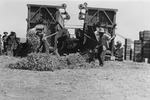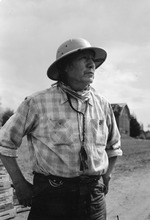View images of Workers of Color
The 1940s were a time of racism and segregation, yet many minority groups participated in the Emergency Farm Labor Service. Of these, African Americans, Japanese Americans, and Native Americans were the three largest groups. Although each minority group faced its own set of challenges, they all endured severe difficulties in order to aid their country.
Coming from a variety of circumstances, the majority of the African Americans that participated in the Emergency Farm Labor Service did not begin their participation until after World War II had ended. This late entrance was primarily due to the face that many African Americans in Oregon had been employed by Portland’s shipyards, many of which closed immediately following the end of the War. As the number of African Americans in the Emergency Farm Labor Service began to grow, however, racial tension also increased. Many farmers refused to hire African Americans and, as a result, segregated African American platoons were created, which acted as a temporary solution until the Emergency Farm Labor Service disbanded in 1947.
During World War II, Japanese Americans in the areas bordering the Pacific coast were evacuated or forced into internment. In May, 1942, however, Malheur County became one of the first areas to begin hiring these evacuees for farm work. Although they worked primarily for Japanese American farmers, facing racial stereotypes elsewhere, more than 1,000 Japanese Americans participated in the Emergency Farm Labor Service between 1943 and 1945. When Executive Order 9066, which was the legal force behind Japanese exclusion, came to an end in January, 1945, many of the evacuees chose to remain in Eastern Oregon.
Similar to the Japanese Americans in Malheur County, the Umatilla Tribe was heavily recruited by the farmers of Umatilla County. Unlike their African American or Japanese American contemporaries, however, Native Americans throughout the state did not face as stringent segregation by the Emergency Farm Labor Service. While a significant population of Native Americans were present throughout the entirety of the Emergency Farm Labor Service’s existence, there was, once more, a surge when Portland’s shipyards began closing down.






